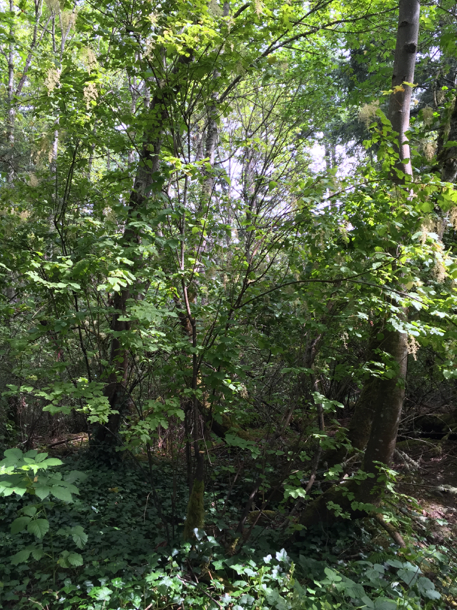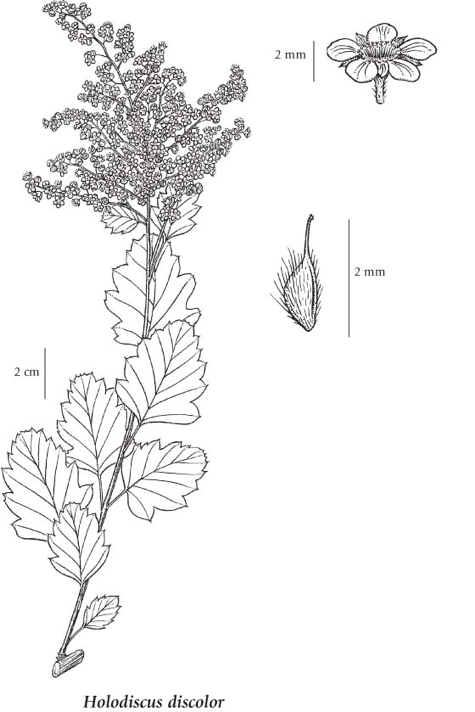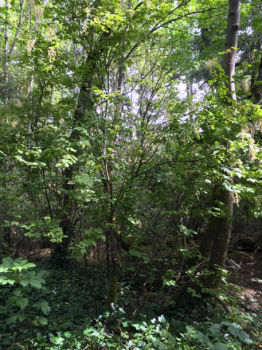Oceanspray ( Holodiscus discolor)

Common Name(s): Oceanspray; Ironwood; Hardhack; Mountain Spray
Scientific Name(s): Holodiscus discolor
Island Hulkemel’em Name(s): qáthelhp
Family: Rosaceae
Cautions: None
Botanical Description: Oceanspray grows from BC to Montana, Colorado, and Arizona. It is a part of the Rose family, characterised by moderately fast growing rates and is long-lived, hardy, and perennial. The swooping branches/stems of oceanspray vary drastically in length, ranging from 6-20 ft. It is even possible for the stems to achieve greater lengths when found in shady or coastal areas. The bark of this shrub is often reddish-grey and will peel away from older stems over time. These stems are scattered with deciduous, alternating, oval leaves, marked with deep veins and shallow lobes, accompanied by very subtle fine teeth on the edges. Oceanspray leaves are light green on top and slightly darker, duller green on the bottom. Clusters of attractive white flowers; however, they can be pinkish, eventually turning beige or brown, hang roughly 4-7+ in. can be seen on oceanspray shrubs. Fruit forms on oceanspray in the late summer; this being said the fruit are dried, one-seeded achenes, predominantly yellowish in colour.[1]

Current Distribution and Local Habitat(s): Oceanspray is typically abundant near the coast, as well as commonly occurring West of the Cascades. In these areas, oceanspray can be found in a vast array of different environments, including stream banks, lower layers of moist woods, dry rock soils, as well as talus slopes. Oceanspray is able to survive in a diversity of environments due to a relatively low need for growth inputs (ie- sun, water, nutrients, etc.). Oceanspray can flourish in both sunny and shaded habitats, with most common soil textures (coarse, medium, fine) with a PH of 5-7.5. Oceanspray is also characterised by lenient fertility and altitude requirements; with altitudes ranging from sea level to 7000 ft., and relatively low fertility requirements.[2]
Ethnobotanical Application(s): Oceanspray has been an important plant in regards to First Nations crafting and tool creation. First Nations have used this plant in many ways throughout history predominantly in the context of a stiff hardwood material as well as for medicinal purposes. The hard straight qualities of this plant make it a desirable wood to build arrows, spears, harpoons etc. with.[3] The wood from this plant can be baked over a bed of hot coals in order to harden it even more.[4] In combination with this, the seeds from oceanspray may be prepared as an infusion in order to treat/prevent diarrhea and other contagious diseases. On top of this, oceanspray's bark and leaves were used to create poultices that could be applied in order to heal wounds or burns on the skin.[5]
UVic Campus Location(s): Oceanspray can be found throughout the majority of campus, as it is often considered an aesthetically pleasing landscaping shrub. Oceanspray’s cluster of little white flowers can be observed all over, especially due to its resiliency and its hardy species characteristic’s.[6]
Figure Reference(s):
Figure 1: Personal Photo, by Conrad Parken, June 2016.
Figure 2: E-Flora BC: Electronic Atlas of the Flora of British Columbia. (2015). Retrieved June 30, 2016, from http://linnet.geog.ubc.ca/Atlas/Atlas.aspx?sciname=Holodiscus discolor
[1] Plants.usda.gov (2016). Plant Fact Sheet: Oceanspray. Retrieved 16 June 2016, from http://plants.usda.gov/factsheet/pdf/fs_hodi.pdf
[2] Ibid.
[3] Ibid.
[4] Turner, N. J., & Turner, N. J. (1998). Plant technology of First Peoples in British Columbia. Vancouver: UBC Press.
[5] Plants.usda.gov (2016). Plant Fact Sheet: Oceanspray. Retrieved 16 June 2016, from http://plants.usda.gov/factsheet/pdf/fs_hodi.pdf
[6] Ibid.
Project Status:
Date Completed:
Year:
Associated Projects:
Image:

